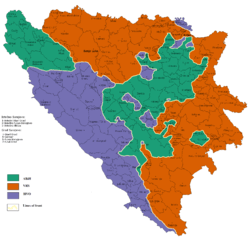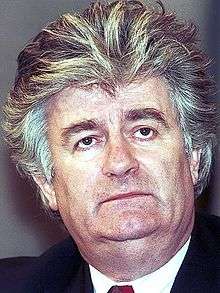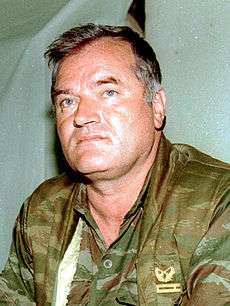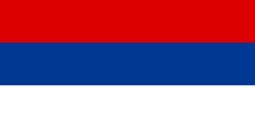Republika Srpska (1991–95)
| Republic of Srpska | ||||||||||||||||||
| Republika Srpska Република Српска | ||||||||||||||||||
| Unrecognized entity, client state of Serbia[1] | ||||||||||||||||||
| ||||||||||||||||||
| ||||||||||||||||||
| Anthem Bože Pravde | ||||||||||||||||||
 Front lines in the Bosnian War, 1995. | ||||||||||||||||||
| Capital | Pale | |||||||||||||||||
| Government | Republic | |||||||||||||||||
| President | ||||||||||||||||||
| • | 1992–1996a | Radovan Karadžić | ||||||||||||||||
| Prime Minister | ||||||||||||||||||
| • | 1992–1993 | Branko Đerić | ||||||||||||||||
| • | 1993–1994 | Vladimir Lukić | ||||||||||||||||
| • | 1994–1995 | Dušan Kozić | ||||||||||||||||
| • | 1995–1996a | Rajko Kasagić | ||||||||||||||||
| Historical era | Breakup of Yugoslavia | |||||||||||||||||
| • | Proclamation | 9 January 1992 | ||||||||||||||||
| • | Constitution | 28 February 1992 | ||||||||||||||||
| • | Independence | 7 April 1992 | ||||||||||||||||
| • | Srebrenica massacre | 11–22 July 1995 | ||||||||||||||||
| • | Dayton Agreement | 14 December 1995 | ||||||||||||||||
| ||||||||||||||||||
| a. | Although Republika Srpska was reincorporated into Bosnia and Herzegovina as an autonomous entity in 1995, these offices continued until 1996. | |||||||||||||||||
During the Bosnian War from 1992 to 1995 Republika Srpska was an unrecognized territory under the control of the Army of the Republika Srpska, while after 1995, it is one of two political entities composing Bosnia and Herzegovina. The borders of Republika Srpska are, with a few negotiated modifications, based on the front lines and situation on the ground at the time of the Dayton Peace Accords. As such, the entity is primarily a result of the Bosnian war without any direct historical precedent. Its territory encompasses a number of Bosnia and Herzegovina's numerous historical geographic regions, but (due to the above-mentioned nature of the inter-entity boundary line) it contains very few of them in entirety. Likewise, various political units existed within Republika Srpska's territory in the past, but very few existed entirely within the region.
Background
Creation

During the political crisis that followed the secession of Slovenia and Croatia from the former Socialist Federal Republic of Yugoslavia on 25 June 1991, a separate Bosnian Serb Assembly was founded on 24 October 1991, as the representative body of Serbs in Bosnia and Herzegovina. Bosnian Serbs claimed that this was a necessary step since the Constitution of Bosnia and Herzegovina, at that time, defined that no major changes were to be granted short of a unanimous agreement on all three sides. Bosniaks and Bosnian Croats wanted independence for Bosnia against the Bosnian Serbs’ wishes.
A referendum that asked citizens whether they wanted to remain within Yugoslavia was held on 9 and 10 November 1991. The parliamentary government of Bosnia and Herzegovina (with a clear Bosniak and Croat majority) asserted that this plebiscite was illegal, but the Bosnian Serb Assembly acknowledged its results. On 21 November 1991, the Assembly proclaimed that all those municipalities, local communities, and populated places in which over 50% of the people of Serbian nationality had voted, as well as those places where citizens of other nationalities had expressed themselves in favor of remaining in a joint Yugoslav state, would be territory of the federal Yugoslav state.
On 9 January 1992, the Bosnian Serb Assembly adopted a declaration on the Proclamation of the Republic of the Serb people of Bosnia and Herzegovina (Republika srpskog naroda Bosne i Hercegovine). On 28 February 1992, the constitution of the Serbian Republic of Bosnia and Herzegovina was adopted and declared that the state's territory included Serb autonomous regions, municipalities, and other Serbian ethnic entities in Bosnia and Herzegovina (including regions described as "places in which the Serbian people remained in the minority due to the genocide conducted against them during World War II"), and it was declared to be a part of the federal Yugoslav state.
From 29 February to 2 March 1992, Bosnia and Herzegovina held a referendum on independence. The majority of Bosnian Serbs boycotted the vote on the grounds that it was unconstitutional because the referendum bypassed the veto power of the representatives of the Serbian people in the Bosnian parliament. On 6 April 1992, the European Union formally recognized the independence of Bosnia and Herzegovina. The Serbian Republic of Bosnia and Herzegovina declared its independence on 7 April 1992. On 12 August 1992, the reference to Bosnia and Herzegovina was dropped from the name, and it became simply Republika Srpska.
During the breakup of Yugoslavia, Srpska's President Radovan Karadžić declared that he did not want Srpska to be in a federation alongside Serbia in Yugoslavia, but that Srpska should be directly incorporated into Serbia.[2]
Bosnian War
On 12 May 1992, at a session of the Bosnian Serb Assembly, Radovan Karadžić announced the six "strategic objectives" of the Serbian people in Bosnia and Herzegovina:[3]
- Establish state borders separating the Serbian people from the other two ethnic communities.
- Set up a corridor between Semberija and Krajina.
- Establish a corridor in the Drina river valley, that is, eliminate the Drina as a border separating Serbian states.
- Establish a border on the Una and Neretva rivers.
- Divide the city of Sarajevo into Serbian and Bosniak parts and establish effective state authorities in both parts.
- Ensure access to the sea for Republika Srpska.
At the same session, the Bosnian Serb Assembly voted to create the Army of the Republika Srpska (VRS) (Vojska Republike Srpske), and appointed Ratko Mladić, the commander of the Second Military District of the Yugoslav federal army, as commander of the VRS Main Staff. At the end of May 1992, after the withdrawal of Yugoslav forces from Bosnia and Herzegovina, the Second Military District was essentially transformed into the Main Staff of the VRS. The new army immediately set out to achieve by military means the six "strategic objectives" of the Serbian people in Bosnia and Herzegovina (the goals of which were reaffirmed by an operational directive issued by General Mladić on 19 November 1992).
The VRS expanded and defended the borders of Republika Srpska during the Bosnian War. By 1993 Republika Srpska controlled about 70% of the territory of Bosnia and Herzegovina with final agreement (Dayton Agreement) in 1995 appropriating to Republika Srpska control over 49% of the territory.
In 1993 and 1994, the authorities of Republika Srpska ventured to create the United Serb Republic.
War crimes
Since the beginning of the war, the VRS (Army of Republika Srpska) and the political leadership of Republika Srpska have been accused of war crimes, crimes against humanity, genocide, ethnic cleansing of the non-Serb population, creation and running of detention camps (variably also referred to as concentration camps and prisoner camps), and the destruction of the Bosnian-Herzegovinian cultural and historical heritage.
Independent observers generally agree that Bosnian Serbs bear the overwhelming preponderance of rapes and other war crimes. Their victims were primarily Bosniaks but also Croats.[4]
In a highly classified report by the CIA that was leaked by the press revealed that: Serbs were the first to commit atrocities, carried out 90 percent of war crimes, and was the only party that systematically attempted to "eliminate all traces of other ethnic groups from their territory".[4][5][6]
The gravest of those offenses were the Srebrenica Genocide in 1995, where nearly 8,000 Bosniak men and boys were systematically executed by the VRS, and the long military siege of Sarajevo that resulted in 12,000 civilian casualties.
Ethnic cleansing of non-Serb population was particularly common in the territories of Bosanska Krajina region and Drina river valley. In many instances the procedure was conducted through well organized and efficient bureaucracy set up by the Republika Srpska authorities such as in the case of Banja Luka. Those and other cases of ethnic cleansing dramatically changed the demographic picture of Republika Srpska and Bosnia and Herzegovina.
Many Republika Srpska officials were also indicted for creation and running of detention camps, in particular Omarska, Manjaca, Keraterm, Uzamnica and Trnopolje where thousands of detainees were held. Duško Tadić, former SDS leader in Kozarac and a former member of the paramilitary forces supporting the attack on the district of Prijedor, was found guilty by the ICTY of crimes against humanity, grave breaches of the Geneva Conventions, and violations of the customs of war at Omarska, Trnopolje and Keraterm detention camps.[7] In Omarska region around 500 deaths have been confirmed associated with these detention facilities.
According to the findings of the State Commission for the Documentation of War Crimes on the Territory of Bosnia and Herzegovina, 68.67% or 789 congregational mosques were either destroyed or damaged during the Bosnian War by the VRS and other unidentified individuals from the Republika Srpska.[8] The majority of destroyed mosques had been classified as Bosnian-Herzegovinian national monuments; some, mostly built between the 15th and 17th centuries, were listed with UNESCO as world heritage monuments. Many Catholic churches in the same territory were also destroyed or damaged especially during 1995.
In addition to sacred monuments many secular monuments were also heavily damaged or destroyed by VRS forces such as the National Library in Sarajevo. The Library was set ablaze by shelling from VRS positions around Sarajevo during the siege in 1992.
While the individuals responsible for destruction of national heritage have not yet been found, or indicted, it has been widely reported by international human rights agencies that the "Bosnian Serb authorities issued orders or organized or condoned efforts to destroy Bosniak and Croatian cultural and religious institutions".[9] In other cases such as the Ferhadija Mosque case (Islamic Community in Bosnia and Herzegovina v. Republika Srpska) it was found that: "Banja Luka authorities had actively engaged in, or had at least passively tolerated, discrimination against Muslims on the basis of their religious and ethnic origin." and that "[...] the Serb government [Republika Srpska], had failed to meet its obligation under the Human Rights Agreement to respect and secure the right to freedom of religion without discrimination."[10] A local magistrate ruled that the authorities of the Bosnian Serb controlled town Banja Luka must pay $42 million to its Islamic community for 16 local mosques destroyed during the 1992–1995 Bosnian war.[11]
The prosecution proved that genocide was committed in Srebrenica and that General Radislav Krstić, among others, was personally responsible for that.
Olga Kavran, Deputy Coordinator,
ICTY Outreach Programme[12]


In 1993, the United Nations Security Council created the International Criminal Tribunal for the former Yugoslavia (ICTY) at The Hague for the purpose of bringing to justice persons allegedly responsible for serious violations of international humanitarian law in the territory of the former Yugoslavia since 1991. On 24 July 1995, the Hague Tribunal indicted Radovan Karadžić[13] and Ratko Mladić[3] on charges of genocide and crimes against humanity; on 14 November 1995, both men were indicted again on charges specific to the Srebrenica massacre. On 2 August 2001, the Hague Tribunal found General-Major Radislav Krstić, the commander of the VRS Drina Corps at the time responsible for the Srebrenica massacre, guilty of genocide.[13] Many other political leaders of Republika Srpska and VRS officers, have been indicted, tried, and convicted by the Hague Tribunal for war crimes and crimes against humanity committed during the 1992–1995 war in Bosnia. Some of them (including Mladić) remain at large and in hiding.
In 2006, a list of nearly 28,000 individuals who, according to the Republika Srpska authorities, were involved in Srebrenica massacre alone was released; 892 of those allegedly responsible still hold the positions in the local government of Republika Srpska.[14] The arrests and trials of all war crime suspects are ongoing and their trials are planned to be held at the newly established Bosnian Herzegovinian Tribunal for the War Crimes. The trials of all suspected war criminals are expected to last for years to come.
Two days after international judges in The Hague ruled that Bosnian Serb forces had committed genocide in the killing of nearly 8,000 Muslims in Srebrenica in 1995. "The government of the Republika Srpska expressed its deepest regret for the crimes committed against non-Serbs and condemned all persons who took part in these crimes during the civil war in Bosnia" the statement said.[15]
Controversy

Various allegations have been made particularly since 2001 with the regard to the level of ethnic cleansing and killings of Serb civilians in the regions controlled by the Bosniak government and de facto Croat government of Herzeg-Bosnia during the war. These allegations claimed that ethnic Serb civilians were killed, including Serbs living in Sarajevo, by the Bosniak and Croat authorities and that Republika Srpska authorities have acted as a response to those alleged crimes.
Killings were allegedly carried out during the chaotic early months of the Siege of Sarajevo before law and order were properly established, as well as by Musan Topalović, a renegade officer outside of army control who was liquidated by the government in the second half of 1993.
As a result of Operation Storm, nearly 200,000 Serbs fled from Croatia and a large portion of them found refuge in Bosnia (especially in Republika Srpska). Also during and after the war (when Dayton Agreement was signed), some Serbs left Sarajevo and other parts of Federation of Bosnia and Herzegovina entity particularly after the territorial provisions were enforced to comply with the Dayton agreement. Also many Serbs left Sarajevo after Momčilo Krajišnik, a former president of RS, invited Serbs to live in Republika Srpska entity.
Numerous detention camps were established, and executions occurred, in the parts of Sarajevo firmly held by Serb forces (i.e. Ilidža). Furthermore, various international and state agencies have reported that most Serbs killed in Sarajevo were killed by and from the VRS positions that surrounded Sarajevo and were counted as part of the total 12,000 civilian casualties. Such reports have been backed by forensic analysis and medical records that were kept at the Sarajevo hospitals. No indictments have been filed with ICTY or any other legal agency to consider claims by the Republika Srpska government. On the other hand Stanislav Galić the commander of the VRS forces responsible for the Siege of Sarajevo has been found guilty by the ICTY.[16]
Army
Economy
Aftermath


Reforms
After the war numerous laws were passed by the Republika Srpska authorities under the auspices of the international community acting through the Office of the High Representative (OHR). Many laws dealt with the issues and consequences of the war and served to repair some of the problems created such as annulments of ill-fate contracts that required non-Serbs to "voluntarily" turn over their properties to the Republika Srpska including real-estates and businesses taken during the war.
Many constitutional changes were also made to change the social character of the Republika Srpska from mono-ethnic to a multi-ethnic entity and thus including Bosniaks and Croats as constituent people of Republika Srpska. Some of the names of the cities that were changed during the war by the authorities of Republika Srpska were changed back. Most of the changes were done as to retract effects of ethnic cleansing and allow refugees to return, but also as a response to numerous reports of human rights abuses that were taking place in the entity.[17]
However, most of the changes had very little effect on a return of more than a million refugees. Intimidation of returnees were quite common and occasionally escalated into violent riots as in the case of Ferhadija mosque riots in Banja Luka in 2001.[18][19][20][21] Consequently, the views concerning Republika Srpska are different among various ethnic groups within the Bosnia and Herzegovina. For Serbs, the Republika Srpska is a guarantee for their survival and existence as a people within these territories. On the other hand, for some ethnic Bosniaks, who were ethnically cleansed from Republika Srpska, the creation, existence, name and insignia of this entity remains a matter of controversy.
Report on Srebrenica
In September 2002, the Republika Srpska Office of Relations with the ICTY issued the "Report about Case Srebrenica". The document, authored by Darko Trifunović, was endorsed by many leading Bosnian Serb politicians. It concluded that 1,800 Bosnian Muslim soldiers died during fighting and a further 100 more died as a result of exhaustion. "The number of Muslim soldiers killed by Bosnian Serbs out of personal revenge or lack of knowledge of international law is probably about 100...It is important to uncover the names of the perpetrators in order to accurately and unequivocally establish whether or not these were isolated instances."[22] The International Crisis Group and the United Nations condemned the manipulation of their statements in this report.[23]
In 2004, the international community's High Representative Paddy Ashdown had the Government of Republika Srpska form a committee to investigate the events. The committee released a report in October 2004 with 8,731 confirmed names of missing and dead persons from Srebrenica: 7,793 between 10 and 19 July 1995 and further 938 people afterwards.
The findings of the committee remain generally disputed by Serb nationalists, who claim it was heavily pressured by the High Representative, given that an earlier RS government report which exonerated the Serbs was dismissed. Nevertheless, Dragan Čavić, the president of Republika Srpska, acknowledged in a televised address that Serb forces killed several thousand civilians in violation of the international law, and asserted that Srebrenica was a dark chapter in Serb history.[24]
On 10 November 2004, the government of Republika Srpska issued an official apology. The statement came after a government review of the Srebrenica committee's report. "The report makes it clear that enormous crimes were committed in the area of Srebrenica in July 1995. The Bosnian Serb Government shares the pain of the families of the Srebrenica victims, is truly sorry and apologises for the tragedy." the Bosnian Serb government said.[25]
In April 2010, a resolution condemning the crimes committed in Srebrenica was rejected by representatives of parties from Republika Srpska.[26]
In April 2010, Milorad Dodik, the prime minister of Republika Srpska, initiated a revision of the 2004 report saying that the numbers of killed were exaggerated and the report was manipulated by a former peace envoy.[27] The Office of the High Representative responded and stated that: "The Republika Srpska government should reconsider its conclusions and align itself with the facts and legal requirements and act accordingly, rather than inflicting emotional distress on the survivors, torture history and denigrate the public image of the country".[28]
References
- ↑ Sara Darehshori, Human Rights Watch (Organization). Weighing the Evidence: Lessons from the Slobodan Milosevic Trial, Volume 18. Human Rights Watch, 2006. Pp. 19.
- ↑ Daily report: East Europe, Issues 191–210. Front Cover United States. Foreign Broadcast Information Service. Pp. 38. (A recorded conversation between Branko Kostic and Srpska's President Radovan Karadzic, Kostic asks whether Karadzic wants Srpska to be an autonomous federal unit in federation with Serbia, Karadzic responds by saying that he wants complete unification of Srpska with Serbia as a unitary state similar to France.)
- 1 2 "Prosecutor v. Ratko Mladic – Amended Indictment" (PDF). United Nations International Criminal Tribunal for the former Yugoslavia. 2 August 2001.
- 1 2 Kressel, Neil Jeffrey (2002). Mass Hate: Global Rise to Genocide and Terror. Westview Press. p. 15. ISBN 0-8133-3951-0.
- ↑ Cohen, Roger (9 March 1995). "C.I.A. Report on Bosnia Blames Serbs for 90% of the War Crimes". New York Times.
- ↑ Thomas Cushman, Thomas Cushman (1996). This Time We Knew: Western Responses to Genocide in Bosnia. New York University Press. p. 94. ISBN 0-8147-1535-4.
- ↑ "Prosecutor v. Duško Tadić – Judgement" (PDF). International Criminal Tribunal for the former Yugoslavia. 14 July 1997.
- ↑ Riedlmayer, András J. "From the Ashes: The Past and Future of Bosnia's Cultural Heritage" (PDF). Harvard University.
- ↑ "War Crimes in Bosnia-Hercegovina: U.N. Cease-Fire Won't Help Banja Luka". Human Rights Watch. 6 (8). June 1994.
- ↑ Dakin, Brett (2002). "The Islamic Community in Bosnia and Herzegovina v. The Republika Srpska: Human Rights in a Multi-Ethnic Bosnia". Harvard Human Rights Journal. 15.
- ↑ "Serbs ordered to pay for mosques". BBC News. 20 February 2009.
- ↑ "Bridging the Gap in Srebrenica, Bosnia and Herzegovina". ICTY. Retrieved 20 April 2010.
- 1 2 "Prosecutor v. Radovan Karadžić – Third Amended Indictment" (PDF). United Nations International Criminal Tribunal for the former Yugoslavia. 27 February 2009.
- ↑ "Srebrenica Suspects Revealed". Institute for War & Peace Reporting. 25 August 2006.
- ↑ Wood, Nicholas (1 March 2007). "Serbs Apologize To War Victims". New York Times.
- ↑ "Prosecutor v. Stanislav Galić Judgement" (PDF). International Criminal Tribunal for the former Yugoslavia. 30 November 2006.
- ↑ "Violence against minorities in Republika Srpska must stop". Amnesty International. 11 October 2001.
- ↑ McMahon, Robert (9 May 2001). "UN: Officials Alarmed By Mob Violence In Bosnia". Radio Free Europe/Radio Liberty.
- ↑ Strauss, Julius (8 May 2001). "Serb mob attacks Muslims". The Daily Telegraph. London. Retrieved 30 March 2010.
- ↑ "UN condemns Serb 'sickness'". BBC. 8 May 2001.
- ↑ "Bosnian Serb Crowd Beats Muslims at Mosque Rebuilding". The New York Times. 8 May 2001. Retrieved 30 March 2010.
- ↑ Report about Case Srebrenica – Banja Luka, 2002
- ↑ Imaginary Massacres?, TIME Magazine, 11 September 2002
- ↑ Topić, Tanja (1 July 2004). "Otvaranje najmračnije stranice" (in Serbian). Vreme.
- ↑ "Bosnian Serbs issue apology for massacre". Associated Press. 11 November 2004.
- ↑ "Bosnia Lawmakers Reject Srebrenica Resolution". Balkan Investigative Reporting Network. 8 April 2010.
- ↑ "Envoy slams Bosnia Serbs for questioning Srebrenica". Reuters. 21 April 2010. Retrieved 21 April 2010.
- ↑ "RS Government Special Session A Distasteful Attempt to Question Genocide". OHR. 21 April 2010. Retrieved 21 April 2010.
External links
| Wikimedia Commons has media related to History of Republika Srpska. |
- A precarious peace, The Economist, 22 January 1998

